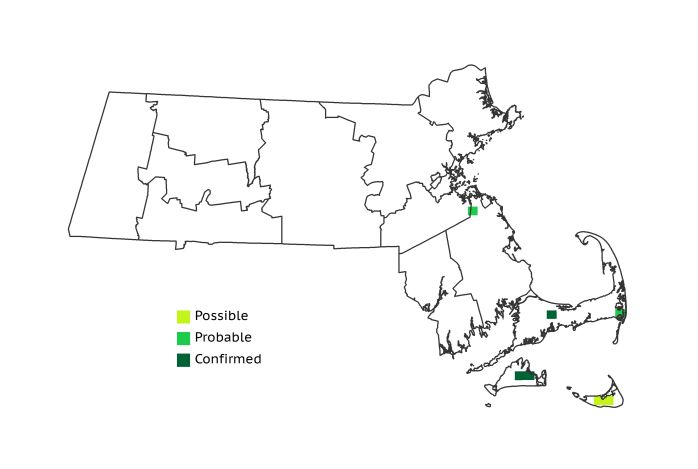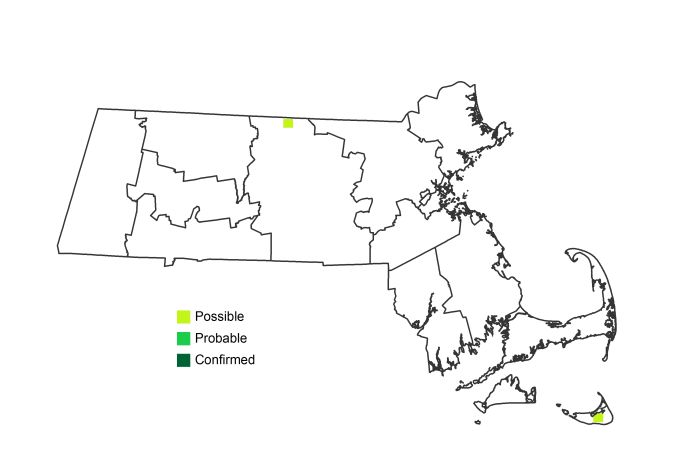Find a Bird
Long-eared Owl
Asio otus

Very local, trend not established
Conservation action urgent
Species of Special Concern
“The winter owl banked just in time to pass / And save herself from breaking window glass.” – Robert Frost, “Questioning Faces”
With their ear tufts erect and their yellow eyes wide, Long-eared Owls seem to show a surprised expression. They are widespread breeders to the north and west of Massachusetts, but the Bay State continues to host an apparently minuscule breeding population of its own, in addition to a number of regular winter residents. Though they pass the daylight hours in conifer stands, these nocturnal predators prefer to do their foraging in open country, so it is not surprising that they are less commonly encountered than they once were. Today, the mixed conifer thickets and fire-maintained grasslands of the Cape and Islands offer the last, best hope for the regular breeding Long-eared Owls in Massachusetts.
Historic Status
In the days when the mixture of forested landscape and open farmland was widespread, Long-eared Owls were apparently also more numerous in the state. Largely understudied throughout most of the state’s settled history because of its particularly nocturnal habits, the Long-eared Owl had historic population levels that may never be fully understood. Anecdotal reports, like those of Edward Howe Forbush, writing in 1927, claimed, “It once nested rather commonly within the present limits of the city of Boston and a nest has been found there within recent years.” To most historical observers, however, this species was always considered more of a migrant than a breeder.
Atlas 1 Distribution
Even in winter, when this species tends to be most frequently reported, the quiet and reclusive Long-eared Owl is a difficult bird to find. In Atlas 1, the problem was compounded by an extremely small and apparently shrinking breeding population. Long-eared Owls were found only in conifer-dominated forests in the southeastern part of the state. Aside from a lonely single Probable block in Weymouth in the Coastal Plains, all breeding activity recorded during Atlas 1 was on Cape Cod and the Islands. Stands of Red Pine on Martha’s Vineyard seemed to be particularly favored habitat for Long-ears, though mainland Cape Cod and Nantucket each had some evidence of breeding owls.
Atlas 2 Distribution and Change
The apparently shrinking breeding population of Atlas 1 became a definitely shrinking population by Atlas 2. After five years in the field, Atlas workers were unable to establish any Confirmations, and only two Possible nesting sites were identified, one on Nantucket and one in northern Worcester County. The Nantucket report pertained to two birds, presumed to be young, seen at the end of May, although their age was never positively determined and they were never relocated. The Worcester County bird was only heard once in late May.
Atlas 1 Map

Atlas 2 Map

Atlas Change Map

Ecoregion Data
Atlas 1 | Atlas 2 | Change | ||||||
Ecoregion | # Blocks | % Blocks | % of Range | # Blocks | % Blocks | % of Range | Change in # Blocks | Change in % Blocks |
Taconic Mountains | 0 | 0.0 | 0.0 | 0 | 0.0 | 0.0 | 0 | 0.0 |
Marble Valleys/Housatonic Valley | 0 | 0.0 | 0.0 | 0 | 0.0 | 0.0 | 0 | 0.0 |
Berkshire Highlands | 0 | 0.0 | 0.0 | 0 | 0.0 | 0.0 | 0 | 0.0 |
Lower Berkshire Hills | 0 | 0.0 | 0.0 | 0 | 0.0 | 0.0 | 0 | 0.0 |
Vermont Piedmont | 0 | 0.0 | 0.0 | 0 | 0.0 | 0.0 | 0 | 0.0 |
Berkshire Transition | 0 | 0.0 | 0.0 | 0 | 0.0 | 0.0 | 0 | 0.0 |
Connecticut River Valley | 0 | 0.0 | 0.0 | 0 | 0.0 | 0.0 | 0 | 0.0 |
Worcester Plateau | 0 | 0.0 | 0.0 | 1 | 1.1 | 50.0 | 0 | 0.0 |
Lower Worcester Plateau | 0 | 0.0 | 0.0 | 0 | 0.0 | 0.0 | 0 | 0.0 |
S. New England Coastal Plains and Hills | 1 | 0.4 | 14.3 | 0 | 0.0 | 0.0 | -1 | -0.4 |
Boston Basin | 0 | 0.0 | 0.0 | 0 | 0.0 | 0.0 | 0 | 0.0 |
Bristol and Narragansett Lowlands | 0 | 0.0 | 0.0 | 0 | 0.0 | 0.0 | 0 | 0.0 |
Cape Cod and Islands | 6 | 4.4 | 85.7 | 1 | 0.7 | 50.0 | -5 | -4.2 |
Statewide Total | 7 | 0.7 | 100.0 | 2 | 0.2 | 100.0 | -6 | -0.7 |
Notes
The Long-eared Owl may be nearly gone from Massachusetts as a regular breeding species, and future observers should follow up on all reports of late-spring and early-summer occurrences of Long-eared Owls in the Commonwealth.



